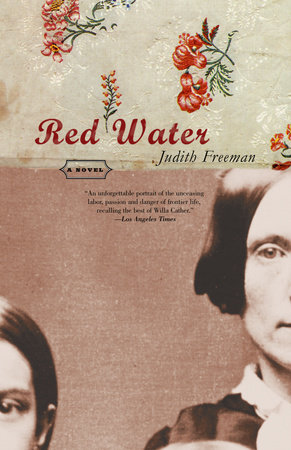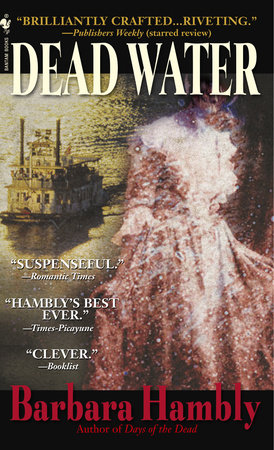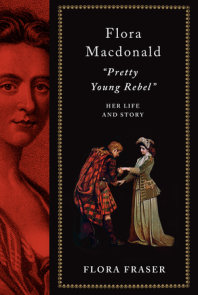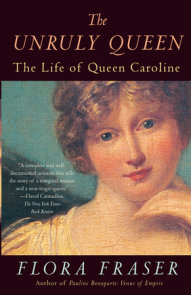Author Q&A
A Conversation with
FLORA FRASER
author of
PRINCESSES
The Six Daughters of George III
Q: Biography is clearly in your blood. Not only because your mother, Lady Antonia Fraser, and your grandmother, Lady Elizabeth Longford, were successful biographers but this is now your third biography.
A: I suppose it is rather striking that we are three generations of biographers. But of course to me it seems entirely natural, and enjoyable to have my mother—and, until her recent death, my grandmother—as colleagues in this feminine, or even feminist family business. At any rate, I owe them both an enormous amount. First, they were both expert storytellers when we were young children, and the subject matter of their stories was as often historical—Robin Hood, King Arthur, Robert the Bruce—as it was myth, legend or fairytale. Later, when I was growing up, the subjects on whom my mother and grandmother worked (Mary Queen of Scots, Queen Victoria, Wellington, and Cromwell) were like extra characters—and very colorful characters—around the house.
Additionally, my mother and grandmother paid me as a fact-checker in the school holidays. I had a reader’s pass for the British Library at the age of 15, I think. Meanwhile tap-tap-tap went the typewriter upstairs, and every four years, not at all as if by magic but very plainly as a result of hard work, my mother produced another book. So I grew up thinking writing biography was an interesting, paying, demanding, but rewarding trade to go into. I did rebel in my teens, but by the age of 22 I was embarked on a life of Emma Hamilton. And I’ve never looked back.
Q: What led you to the subjects of Emma, Lady Hamilton, Queen Caroline and now to the relatively unknown six daughters of George III?
A: I suppose I never really got over the satisfaction of Jane Austen’s prose and plots, and I have of course read all of Georgette Heyer’s books at least twice. So it seemed natural, after Oxford, when I decided to write a biography, to choose someone eighteenth century. It was my mother who suggested the subject of Emma Hamilton. I had studied classics at Oxford and initially wanted to write the biography of her husband, Sir William, a distinguished diplomat and antiquarian. But it turned out that there was an excellent, recent biography of him so I turned to his notorious wife Emma, Lord Nelson’s great love. As I had had a childhood passion for Nelson ever since I saw his portrait in the National Portrait Gallery, I was happy to make the change.
As for Queen Caroline, George IV’s estranged wife, it was my editor at Knopf, Bob Gottlieb, who suggested it. He had got a book about her trial for adultery in the House of Lords off a second-hand bookstall, and rang me from New York to recommend my writing her life. An inspired suggestion. That book took me into the treasure trove that is the Royal Archives at Windsor Castle, and to twenty-nine boxes of papers concerning Queen Caroline and her very rocky relations with her husband when they were Prince and Princess of Wales. While I was working in the Royal Archives, the voices of Queen Caroline’s sisters-in-law, ‘mad’ King George III’s daughters so intrigued me that I decided to write their group biography. Princesses is the result.
Q: How unusual was it for these princesses (among the European royalty of the era) to have parents who treated their education as seriously as their sons’?
A: It was most unusual. The daughters of George III were fortunate in their mother, Queen Charlotte, who believed strongly in female education. She drew the line at Latin and Greek, but ruthlessly purloined tutors in every other subject—from German to physics—intended for her nine sons’ education, and set them to educating her daughters. Queen Charlotte sat in on lessons herself, ruing her own inadequate education in Northern Germany. She also hired tutors and teachers for her daughters in the more usual feminine branches of knowledge, embroidery, flower-painting, drawing. But here again the princesses were educated way above the norm, for they were assiduous and gifted students. Princess Elizabeth became a celebrated amateur artist and published her work. And their mother, although parsimonious in other areas, was almost reckless in her payments to artists and musicians and others who taught her daughters. Besides this, the princesses and their mother read non-stop in English, French, German, and Italian, as their booksellers’ bills show. History, fiction, belle-lettres, natural science, theology, you name it. In fact, Queen Charlotte got quite into debt in pursuit of her wish that her daughters should be educated to what we would now call university standard and beyond.
Q: Queen Charlotte bore 15 children and even though she started at the relatively young age of 20, wasn’t this a bit unusual for a royal, once there were enough heirs?
A: As with so much about George III and Queen Charlotte, I think it was a matter of personal preference for a large family, rather than any anxiety about the succession. George III loved his children best—certainly his sons—when they were children. Psychologists might read a lot into that. The Queen became less happy with the pattern of childbearing as she grew older, and once, when heavily pregnant, said that no prisoner prayed more to be released from his chains than she. But she would not have dreamt of resisting the King’s wish for a happy, domestic, and Christian home (the opposite of his own childhood experience).
Q: Thanks to playwright Alan Bennett, many people today know about the “madness” of King George. We know he did not want his daughters to marry and leave him. Do you think his reluctance, when he was of sound mind, had more to do with the unhappy fates of his sisters, who’d married and lived abroad, or was it something else?
A: I think the King did regret having assented to marriages that made his sisters so unhappy. But I think he was also in some ways a man of very simple wants, and he wanted to keep his daughters, whom he loved greatly, at home. Not being imaginative, he could not imagine how they could be happier elsewhere. As far as we can see, he was very rarely questioned on this policy, which ensured that none of his six daughters—the premier marital prizes in Europe—ever bore even one legitimate grandchild, and few of them gained the husbands, households and independence which were then most women’s goal.
Q: How much do you think the King’s mental illness affected his daughters emotionally?
A: Oh, they were devastated. The winter of 1788 -89 changed the pattern of their lives, even though the King recovered after six months. From then on their mother, Queen Charlotte, was a broken woman. And the unexpected recurrence of the King’s illness in 1794 was the death blow to their chances of happiness. Though he recovered again, from then on, as Princesses makes clear, the Royal Family, and indeed the Government, feared further recurrences. There were two topics that were deemed likely to bring on another attack if they were mentioned to the King: Catholic emancipation, which he refused to contemplate, and his daughters’ marriages, to which he was still more firmly opposed.
Q: You manage to incorporate so much history and information in a narrative that moves so swiftly, which must not have been an easy task. How long did all the research and piecing together of their lives take you and where did you do most of the research?
A: I began researching Princesses following the publication of The Unruly Queen in 1997, when I was a divorced mother with a nine-year-old daughter. Re-marriage and the births of two sons in the space of thirteen months altered my timetable a little, as did the discovery of a crucial stash of papers in an English manor house. Visiting the German homes of those princesses who ultimately married there was another splendid diversion. But my main research was in the Royal Archives in Windsor Castle, where they ring a bell at eleven and very kindly give researchers a cup of coffee. That’s where the princesses’ letters to their brothers are stored, and it’s a goldmine for the eighteenth-century scholar. Seven years in all, a year’s research per each of the six princesses, as I see it, and one for luck.
Q: What is often most moving are the letters these women wrote describing their lives. Were you surprised by how much there was in this source material and was it hard to choose what to include?
A: The princesses’ letters are intensely moving and they take readers right back there: to the Gothic horror times when their father was ill, to their idyllic childhood at Kew, to a time when hope again dawned, and even to their old age. I knew that the princesses’ voices and personalities were very distinctive from reading their letters when I was researching Queen Caroline. But when I began, I had no idea of the subterranean world of sex, scandal, and family fights that a closer inspection of their letters would reveal.
Q: Was the princesses’ desperate wish to get married primarily for the sake of freedom from their restrained lives at court or do you think they were as interested in romance and love as they were in escape?
A: I think the fact that three of the princesses—Augusta, Sophia, and Amelia—threw themselves into clandestine relationships with their father’s equerries and doctors (whoever was at hand) shows they felt starved for romance and love. Princess Amelia’s letters to her equerry lover are positively pornographic. She revels in their every sexual encounter. However, some of the princesses—Elizabeth and Mary among them—were keener on marriage than romance. (In the dynastic politics of eighteenth-century Europe, princesses were unlikely to get both.) The eldest princess, Royal, was so desperate to marry and acquire a household, independence, and children, that she got her doctors to tell the King she would die if she did not marry. Her plan worked, and she married a man with a stomach so large that his card table had to have a section cut out to accommodate it. He was a domestic tyrant and possibly a wife-beater, but Princess Royal had been so frustrated at home that she never regretted her marriage.
Q: If you had one, who was your favorite princess (or least)? And what did you come to appreciate most about them once you knew them better?
A: Oh Augusta, beyond doubt: from the beginning Princess Augusta was my favorite. I have to admit I am a second sister myself, so I suppose I was naturally drawn to her. But Augusta enthralled me with her loving, witty, irreverent family letters, as much as with her meditations on her father’s illness. Anyone who relishes Jane Austen’s letters, as I do, will enjoy Augusta’s—pleasure laced with pain.
The princess whom I came to appreciate most once I knew her better, was the youngest one, Princess Amelia. Amelia is Byronically reckless in her declarations of love for her soldier lover, and of course she is nearly twenty years younger than her eldest sister. She really does belong to the Romantic generation. Her letters grow wilder and more passionate as illness overtakes her. It was extremely painful to write her death scene, but I believe a success: my mother, when reading it, cried.
Q: Do you have a subject in mind for your next biography?
A: I have just started researching the life of a fascinating woman of the eighteenth century: Pauline Borghese, Napoleon’s favorite sister. It is a fantastic story, starting in Corsica, darting off to Paris and Rome and even Haiti, and taking in Tuscany and the South of France. Nice research opportunities! Lots of palaces. But more seriously, it is also a story about family loyalty and betrayal at the heart of Napoleonic Europe. It will be published in 2008.
Q: How does the present Royal Family compare with the ones you write about?
A: In the early 1990s, when I was writing about Queen Caroline, who did not get on with her husband the Prince Regent, the disagreements of Prince Charles and Princess Diana were continually all over the newspapers in England. I did think that these twentieth-century Royal disagreements did not reach the level of acrimony that existed in the eighteenth century between George and Caroline, and that the twentieth-century newspaper coverage of the Royal Family was not as scurrilous and intrusive as that of the eighteenth century. Nowadays, since the coverage of Princess Diana’s death and other events, I am not so sure.
Nevertheless, the stories of George and Caroline, and of Charles and Diana, have a great deal in common. In both cases, the public resented the Prince of Wales’s treatment of his bride, and regarded her as an “injured wife.” It was well known that George, Prince of Wales had secretly and illegally married a Catholic widow, Mrs. Fitzherbert, before he married Caroline, and he neglected his young bride for this mistress or first “wife.” In the case of Prince Charles, it was again known that his now soon-to-be second wife, Mrs. Parker Bowles, was the true love of his life, and again it became known that he neglected Princess Diana early on for Mrs. Parker Bowles. Hence the indignation when Prince Charles marries the woman who made Princess Diana so unhappy.
The British public, rightly or wrongly, regards the Royal Family as a sort of morality, or even immorality play, or perhaps as akin to a never-ending TV series, in which we, the taxpayers, are part audience, part participant. The public takes up stern positions on new twists in the plot, softens when a prince is young and charming, tut-tuts when another one is young and foolish. Occasionally they think about pulling the plug on the whole series, as in abandoning the monarchy for a republic. But Royal watching is a national sport, and on the whole the Royal Family saga is a lively one, which doesn’t look likely to be banned any day yet.



























